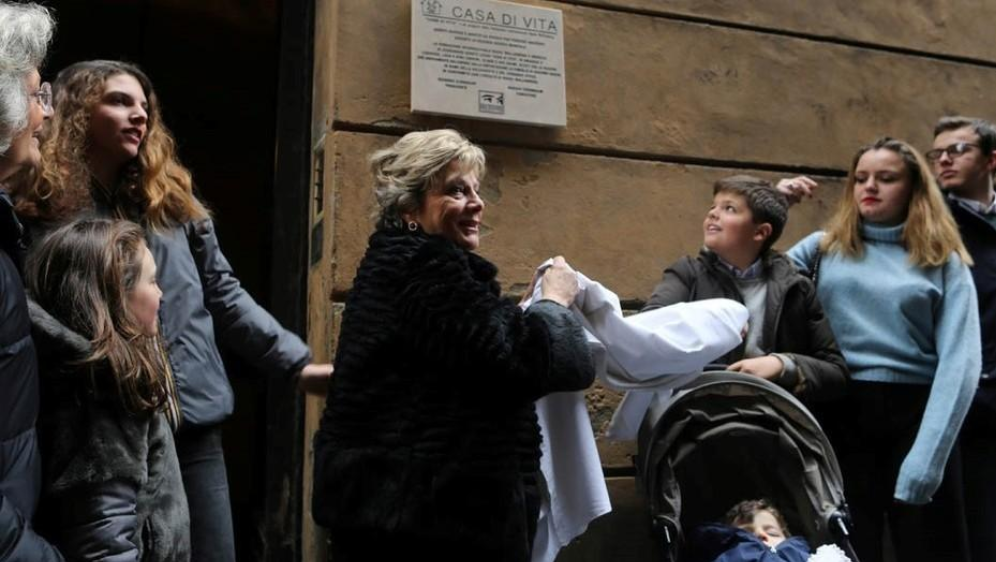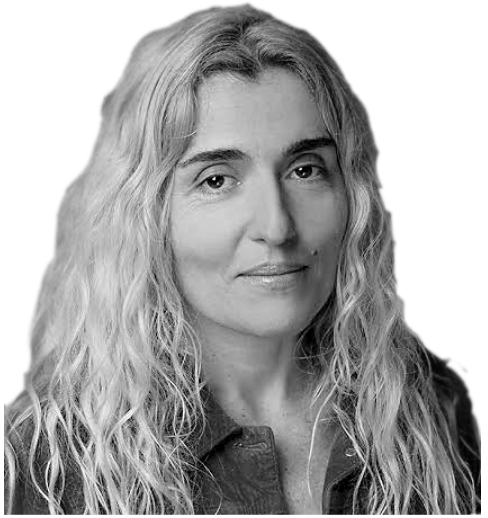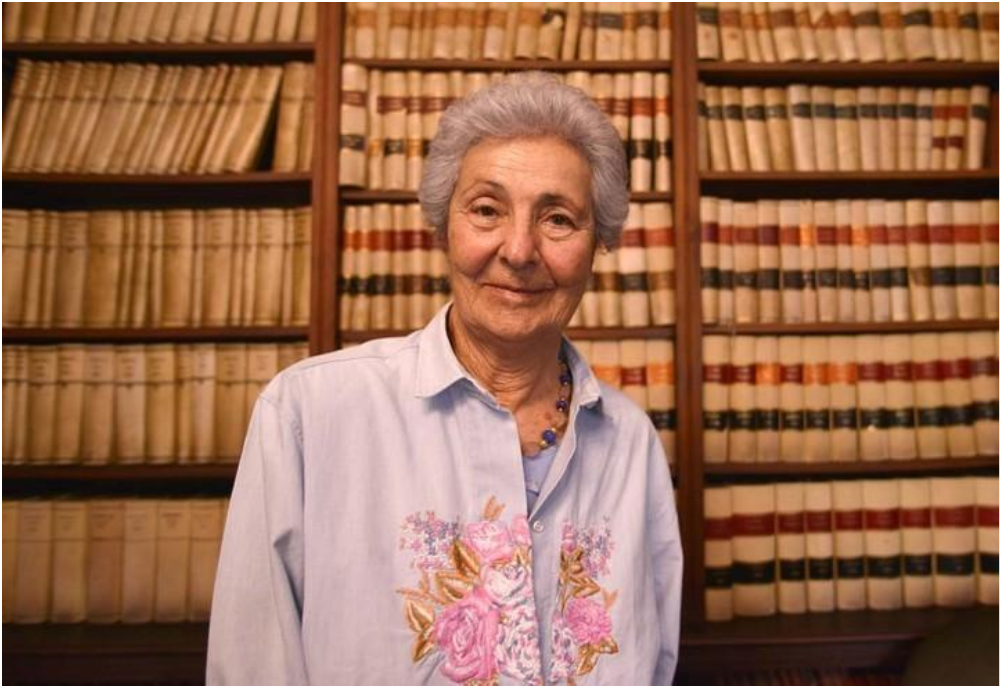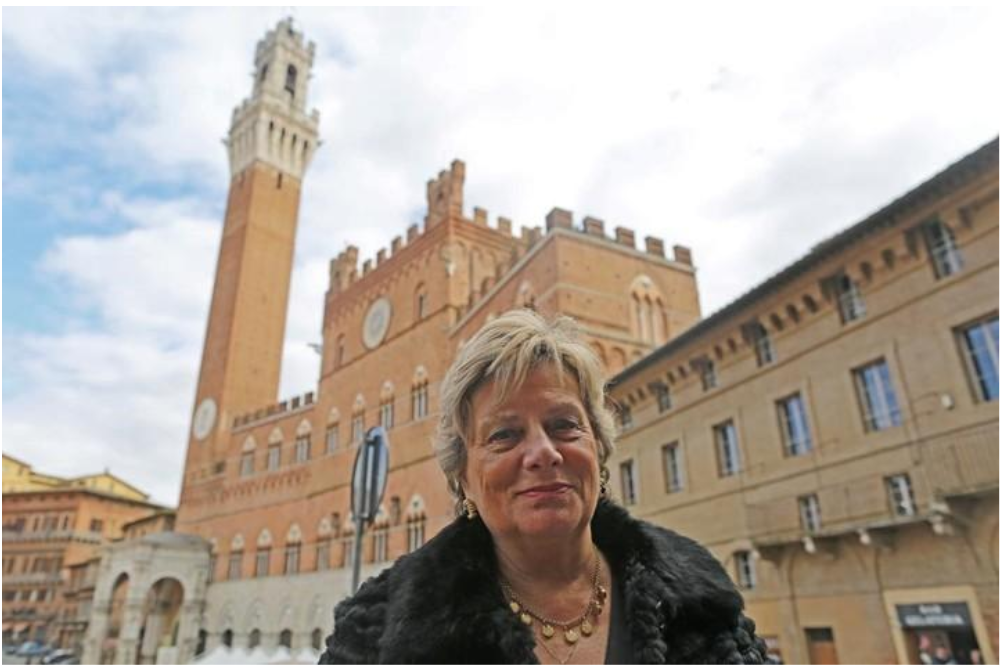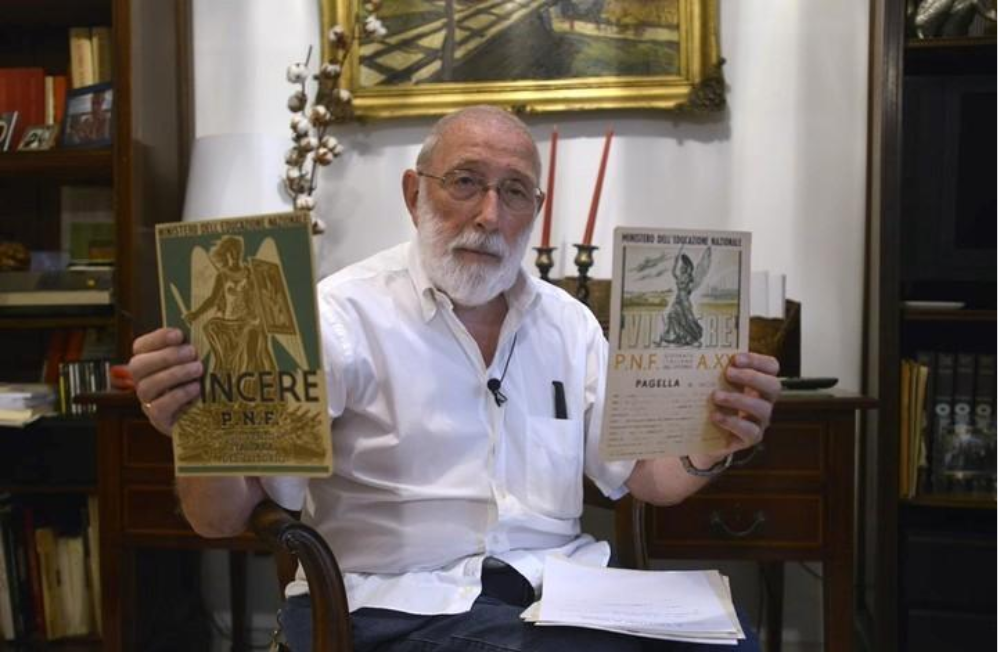The moving story of Jewish children saved from the Holocaust by Catholic families.
Between 1943 and 1945, in Italy, hundreds of Jewish children persecuted by the Nazis found protection in churches, convents and houses belonging to Catholic families. Three of them, tell us the odyssey.
Tribute: Annalisa Sadun unveils a plaque in the house where she was protected from the Nazis when she was a newborn (photo: Cezaro de Luca).
All of a sudden, at age 7, Gianni Polgar became Franco De Renzini. If called by his real name, he knew he should not turn around. Although his parents were alive, he pretended to be an orphan. He could not lean out of the window to greet his play pals because, if discovered, he might have ended up expelled from his family, his neighborhood and the world. He took the first communion and even got a picture with his alleged godfather. Gianni Polgar, a Jewish child, knew by heart the mass in Latin.
Bianca María Campagnano was 9 years-old when she struggled how to respond: “Jewish” or “Catholic” if stopped while walking in the street of Rome, camouflaged as a Christian girl who was just baptized, on her way to visit her parents at an attic, where they hid from the Nazi voraciousness. Bianca did not hesitate; “Jewish”, she would say. She was and felt Jewish.
Between 1943 and 1945, panic corroded the veins of the whole Europe. Nevertheless, Italy was one of the countries that challenged the most the Nazi occupation: Both spontaneous and audacious, the Italians drew a protective sky that protected the Jews against deportation. “During his trial in Jerusalem, Adolf Eichmann, the architect of the Final Solution and the extermination of the Jewish people, stated that amongst the Nazi-occupied countries, Italy was the most difficult one in terms of implementation of the deportation measures, because the Italians, rather than giving away the Jews, protected them by providing them with shelter”, according to Giovanna Sadun, sister of Annalisa, survivor of a Jewish family from Siena, protected by a Catholic one.
“Historical documents recognize the high degree of solidarity displayed by the population. We were under the rule of the Salo and there was a tacit agreement between some local officials and the citizens, who rescued and sheltered Jews. In Italy, for instance, “the number of deportations was lower than in France” says historian Alessandra Staderini, whose parents, when she was one year old, save two Jewish kids, Bianca Maria and Marcelo Campagnno, the children of a befriended family.
The Salo Republic was a fascist invention that Mussolini made up in the north-center area of the country, which was under Nazi control, and which he called the Social Italian Republic. In the wake of WWII, the anti-Semitic monster had already devoured some 6 million people.
However, there were convents, monasteries, churches, religious schools and Catholic families that sheltered Jewish children, whose handed over by their parents into humanitarian custody as they felt the nearing foul-smelling and ferocious breath of the concentration camps.
In the Church of San Giocchino, in Prati, Rome, the priest Antonio Dressiono, allowed, after the armistice of September 8, 1943 – which facilitated the German gruesome search efforts all over Italy, to host Jews and other people persecuted because of their political convictions, and sheltered them at the attic of the church.
They were hidden behind a glass wall and their presence was known by sister Margherita, the nun of the Divine Providence, who was in charge of cooking lunch and dinner for the refugees.
The Jewish community has never forgotten a gesture like this one. In the 60’s, the State of Israel created the Committee of Righteous, whose job is to bestow the title of “Righteous among the Nations” upon every gentile who saved the life of a Jewish person.
Raoul Wallenberg, a Swedish diplomat who risked his own life to save people from the Nazis in Budapest and in 1945 was detained by the Russians never to be seen again, was one of those rescuers.
In his memory, the Argentinian Baruj Tenembaum, a Jewish Gaucho born in Santa Fe, established in 1997 the International Raoul Wallenberg Foundation, an NGO with headquarters in New York and branches is Buenos Aires, Jerusalem and Rome, which deals with educational programs aimed at highlighting the civic courage of those who offered a drop of relief in the Holocaust inferno.
Since 2014, the Foundation promotes Houses of Life, a program aimed at identifying, paying tribute and spreading around to the whole world who, where, how and when the people persecuted by Nazism were sheltered. Whenever the foundation finds a place where a Jew embraced a piece of paradise, thanks to generous souls, it affixes a plaque identifying the site as a House of Life.
“During the Shoa, there were thousands of people that help other members of minorities doomed to die by the Nazis and their allies. Many have been duly recognized. Others, were not”, says the creator of the Foundation, which has the businessman Eduardo Eurnekian as its chairman.
Bianca María Campagnano. She is still in touch with the Staderinis, a Catholic family that protected her when she was 9 years old. She vividly remembers the end of the Nazi nightmare, when her uncle told her, in 1944, that the Germans were fleeing Rome. Photo: Cezaro de Luca.
“The Houses of Life program is our way to thank all these persons in the European continent (in this case, the overwhelming majority of Houses of Life are religious institutions belonging to the Catholic Church) that risked their lives to save others – Tenembaum adds. It is worth mentioning that the fact that there are more than 500 Catholic institutions all over Europe among the Houses of Life, opens a question mark and, at the same time, a challenge about the role played by the Vatican during the years of the war”. So far, more than 500 Houses of Life were identified in Italy, France, Denmark, Hungary, Greece, Poland, and Belgium. According to Silvia Costantini, a point of reference of the foundation in Italy, “each House of Life brings more Houses of Life. We continue discovering a network of help, solidarity, and humanity which is the basis of our project, which one of its objectives is to preserve the memory of goodness, the memory of the elections a person makes at the right time, living aside the danger one can assume”.
Saving Elvira’s children. One night in 1943, Bice Gilardoni, the wife of Fausto Staderini, a Catholic engineer who owned a printing workshop in Rome, dreamt with a voice that told her: “you have to save Elvira’s children”. Elvira was a friend of hers, a member of the Jewish Rome bourgeoisie. She was married, with two children, Bianca Maria and Marcello, and she had been spending the last few days, hidden in a convent, together with her family, facing the dreadful threat of the Nazis.
The Staderinis lived in a villa in Via Nicotera 4. The ground floor served as a law office and the upper floor was inhabited by Bice, Fausto, and their 6 children. “Suddenly, we were eight”, remembers Carla Staderini. The image was embedded in her mind. “When the parents left Bianca Maria and her brother in our home, they put their heads on their heads and prayed in a language I did not know. I had the feeling they were calling for divine protection”.
“The concentration camps became known later, but I was a child and feared the Germans. I thought they were coming after me”, says Bianca Maria. She’s 84 years old and now and then she gathers with the Staderinis, who come and pick her up with their car and bring her to the Vila at Via Nicotera, where the Wallenberg Foundation affixed the House of Life “We were hidden there for 9 months. Even the teacher, Ms. Sanzoni, came secretly to teach us so that we don’t lose the year, says Maria Blanca. The good news came in 1944, the day my uncle called to say he was smoking American cigarettes. What he meant is that the Germans were fleeing.”
Annalisa Sadun. In 1943, with only 4 months, she was protected by the family of Dr. Gino Cardini, a pediatrician, who opened the doors of his house to save her. Photo: Cesaro de Luca.
The courage of a pediatrician. In November 1943, when Annalisa Sadun was a newborn, the Jews of Siena were sinking in despair in light of the atrocious presence of the Germans. Monsignor Luigi Rosadini, from the Vigano Church, did not hesitate and offered refuge to the Saduns, a Jewish family with a 4-months old baby.
Soon afterward, the Saduns found shelter at the house of Dr. Gino Cardini, a pediatrician who was living in a palace located at Via San Pietro 21, in the center of Siena. Nowadays, in front of the old building, which is still inhabited by the Cardinis, there is a souvenir and magazine shop. The fridge magnets cost 3 Euros. “My mother was in desperation because I cried all the time. We were hiding there. Nobody should know about our existence but there was no way to calm the desperate crying of the baby, which I was. Perhaps, I had a feeling of the danger we were in”, says Annalisa Sadun, nowadays a grandmother of 75.
On March 6th, this year, during the celebration of the Day of the Righteous in Siena, Annalisa participated at the ceremony which proclaimed the residence of the Cardinis and the Vignano church as Houses of life. “I have always lived this story as a natural part of my life, says Fiamma Cardini, daughter of the brave Gino. I have never noticed in my parents a sense of fear or hesitation when it came to offering shelter to the Saduns”.
Gianni Polgar. At the age of 7, he was forced to change is identity. He became Franco De Renzini. If someone called his name, he knew he should not turn around and despite the facts his parents were alive, he would pretend he was an orphan. This is how he was protected from Nazism. Photo: Cezaro De Luca.
An imminent danger. “Ever since we were little children, we noticed and knew we were different. I attended the Hebrew section of the Enrico Pestalozzi, nearby the station. There, we received classes that were exclusively given to Jewish children, in different times than the others and we were not allowed to be in touch with other children”, says Gianni Polgar, a retired person from Rome who survived thanks to the director of a Catholic school.
His father was a lawyer and knew an official of the Banco de Roma, who, in light of the imminent danger, referred Gianni to Collegio San Giuseppe – Instituto de Merode. In the course of seven months, Gianni did not step out to the street.
“Once a week, a lady, aunt Annetta, came to visit. In real life, she was my mother. “Don’t call me mommy! If you do, they are going to take both of us”, she would tell me. “I did not see my father during those months”, he adds.
A grandmother, an uncle and a cousin of Polgar were deported and murdered. A female cousin, deported with her husband and son, had managed to come back from a concentration camp. “She rebuilt her life but eventually she committed suicide. She couldn’t cope with the fact she had survived”, says Gianni.
He married a Catholic woman and both decided that if they had children, they would be raised as Jews. “During Friday dinner, we would read the prayer in Hebrew and we were finished, our maid, who was not Jewish, would make the sign of the cross and say “Amen”. Surely, this would not be acceptable for an Orthodox Jew, but I deemed the scene as wonderful”.
When asked if he saw the film “Life is beautiful”, Gianni replied he was not too enthusiastic. “It is moving and profound, in certain aspects, but it has banalized something terrible that happened in Europe, the cradle of civilization”, says Giovanna Sadun.
Gianni Polgar is a living testimony of a legend which came true. Nowadays, he is 82 years old and he visits schools to tell the story of terror and solidarity he experienced as a Jewish child protected by Catholics.
He still recites passages of the mass in Latin.

